An Original Stone Eagle Comes Home to Penn Station in NYC
A 7,500-pound eagle sculpture from the top of the original 1910 Penn Station building has been returned after years in hiding!


Today, the New York metropolitan area contains the largest ethnic Chinese population outside of Asia, with an estimated population of 893,697 as of 2017, As one of 12 Chinatown neighborhoods in the area, Chinatown in Manhattan is home to the highest concentration of Chinese people in the western hemisphere and stands as one of the oldest Chinese ethnic enclaves in the United States. Historically, Chinatown has been primarily populated by Cantonese speakers, but since the 1990s, an influx of Fuzhounese-speaking immigrants have formed their own sub-neighborhood known as Little Fuzhou east of the Bowery.
Though the neighborhood has been overtaken in size by Chinatown’s in Flushing, Queens, and Bensonhurst, Brooklyn, Manhattan’s Chinatown continues to be a haven for Chinese-American culture and cuisine. From its dark and bloody gang history to the rich scenery it has provided for countless films, Manhattan’s Chinatown has much to discover. Read to learn more about the history, culture, and legacy of one of New York City’s most influential and well-known neighborhoods.
Uncover the history of Chinatown before it was Chinatown on an upcoming Untapped New York Insider tour of the neighborhood on May 20th!
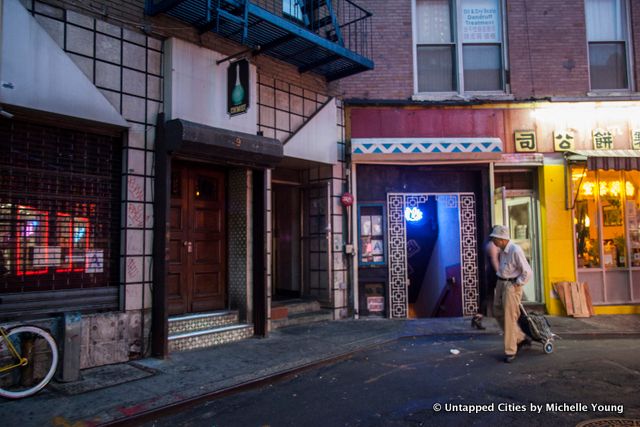
Doyers Street, named after Dutch immigrant Hendrik Doyers, is a 200-foot-long block in Chinatown that bends sharply in the middle at an almost 90-degree angle. Though the street today houses some of Chinatown’s most iconic establishments, including Nom Wah Tea Parlor and Chinese Tuxedo, it was once known as the deadliest street in America — earning the infamous title “The Bloody Angle.”
In the early 1900s, two major factions in Chinatown fought for control of the neighborhood: the Hip Sing Tong (along with their allies the Four Brothers), and the On Leong Tong. Both came to run the area’s opium dens, entertainment centers, and prostitution rings without much interference from local law enforcement. Doyers Street’s Chinese Theatre served as a neutral meeting ground for the two gangs. This all changed on the night of August 7, 1905, when during a performance of a play entitled “The King’s Daughter,” members of the Hip Sing gang fired shots into a crowd of over 400 people, claiming the lives of three.
Tensions continued to escalate between both gangs, reaching a fever pitch in 1909 over the murder of a sex slave named Bow Kum, who was first purchased by a Four Brothers member named Low Hee Tong in San Francisco. After being arrested, Kum was taken to a Christian missionary where she married Tchin Lee, an On Leong Tong member. When Tong demanded the money he paid for Kum from Tchin, his request was denied. In retaliation, on August 15, 1909, a Hip Sing hit man stabbed Kum in the heart, killing her.
What followed was an all-out war that took the lives of more than 50 people. During the fighting, both sides used hatchets as weapons, often waiting around one side of Doyers Street for their victim to turn the corner before slashing them and escaping via a series of underground tunnels. Eventually, as establishments in the area began losing business due to the violence, a truce was finally reached in 1913 — though it would not become permanent until 1994. That same year, a New York Times article published that more people had violently died at “The Bloody Angle” than at any other intersection in America.

During the 19th century, the Five Points neighborhood in Lower Manhattan was the most dangerous area of the city, gaining international notoriety for being a densely populated, disease-ridden, and crime-infested slum. The neighborhood received its name from the intersection of Orange, Anthony, and Cross Streets, which created five corners or “points.” Though this intersection no longer exists, the closest one to where it once was is where Columbus Park meets Worth and Mulberry Streets.
Five Points was built on top of the former Collect Pond, which had been cheaply filled in 1812. As a result, the brick and wood houses built on the pond were unstable and began to sink, creating a neighborhood that only attracted those who could not afford to live elsewhere. The area became a hotspot for crime for the remainder of the century — with its Old Brewery known as the Den of Thieves.
Throughout the 20th century, the neighborhood was gradually redeveloped. Today, the area that was once Five Points is occupied by the Civic Center to the west and south and Chinatown to the east and north. Still, some remnants of the neighborhood exist to this day, including Columbus Park, which was designed by Calvert Vaux, co-creator of Central and Prospect Parks. In Chinatown, visitors can also walk down Mosco Street, which during the mid-1880s was known as Cross Street.
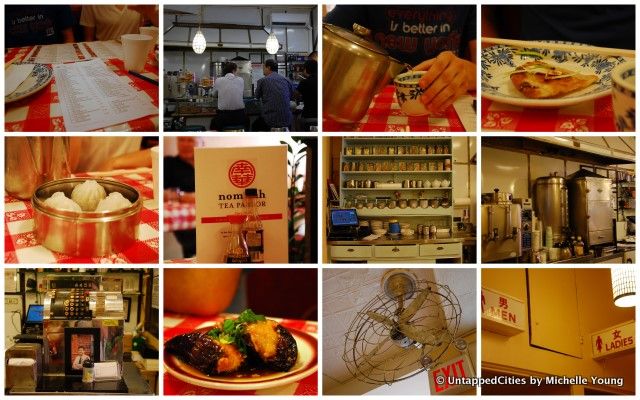
First opened in 1920, Nom Wah Tea Parlor is the oldest continuously running restaurant in Manhattan’s Chinatown and the city’s first dim sum establishment. Though its first owners are unknown, Nom Wah was operated by Ed and May Choy beginning in the 1940s as a bakery and tea parlor with dim sum served on the side. After losing his lease on the bakery portion of the restaurant at 15 Doyers Street in 1968, the restaurant moved into a brand new kitchen at 13-11 Doyers Street. In 1974, Nom Wah was purchased by Wally Tang — who had started working at the restaurant in 1950 at just 16 years old. The restaurant became famous for its lotus paste and red bean filling, which were used to make moon cakes during the Chinese autumn festival.
Beginning in the 1980s, as bakeries began to pop up around Chinatown and the shipping of baked goods from China and Hong Kong became faster and cheaper, Nom Wah began focusing more on selling dim sum to stay afloat. However, even with this transition, the restaurant’s sales continued to decline throughout the 1990s and 2000s. Even so, the restaurant continued to serve as a social club for the network of dim sum chefs across Chinatown.
To bring life back into the restaurant, Tang sold it to his nephew Wilson in 2010. A series of integral changes were made to Nom Wah, including renovations to the kitchen, which had equipment that hadn’t been updated since the 1950s — though the dining area remained mostly untouched besides the addition of checkered tablecloths. In addition, Nom Wah transitioned from being a traditional dim sum restaurant using metal carts to having a made-to-order menu that ensured every item was made fresh and on-demand to produce less waste.
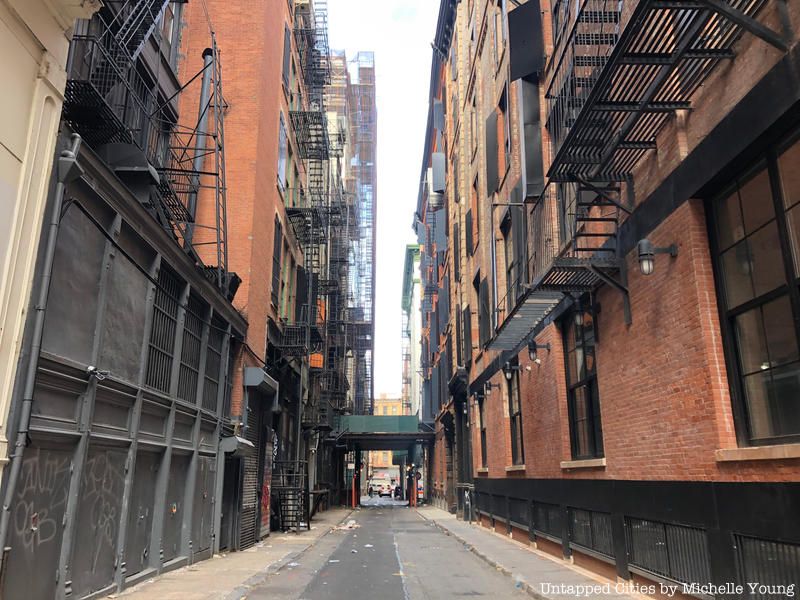
Running for three blocks between Canal and Franklin Streets is Cortlandt Alley. Named after the Van Cortlandt family, who played an integral role in creating the foundations of New York City, the alley was originally laid out in 1817. Over the years — with its old storm shutters, rusty fire escapes, and graffiti on the walls — Cortlandt Alley has been featured in television shows, commercials, and movies to visually portray a dark and gritty side to New York. In Gotham, Bruce Wayne’s parents are mugged and murdered there, while in Crocodile Dundee a street fight takes place. Cortlandt Alley was the main set piece for Vampire Weekend’s music video Cousins.
However, despite its prevalence on the screen, the impression Cortlandt Alley gives is not as accurate as outsiders might be led to believe. Currently, there are only a handful of alleys in Manhattan — all located south of Canal Street. For filmmakers looking to specifically capture a dank dilapidated alley in New York City, only around four to five exist, leaving Cortlandt Alley as one of the few available options. As Nick Carr, a location scout, said in a 2011 interview with Bloomberg’s CityLab, “I try to stress to these directors in a polite way that New York is not a city of alleys. Boston is a city of alleys. Philadelphia has alleys. I don’t know anyone who uses the ‘old alleyway shortcut’ to go home. It doesn’t exist here. But that’s the movie you see. Your impression of New York is that it is the city of alleys.”

In June 2021, the Kimlau War Memorial at Kimlau Square was designated a New York City landmark by the New York City Landmarks Preservation Commission. Though Chinatown houses a number of New York City landmarks, the Kimlau War Memorial is the first that specifically recognizes Chinese American history and culture. For almost 60 years, the memorial’s granite ceremonial gateway — which is sponsored by the American Legion — and a pair of benches have stood as community monuments honoring the Chinese American soldiers who lost their lives while serving in the U.S. military.
The arch and plaza were named after Second Lieutenant Benjamin Ralph Kimlau, who died in 1944 during World War II. Before graduating from Pennsylvania Military College in 1942 as the only Chinese American person in his class, Kimlau lived in Chinatown. Kimlau went on to serve in the U.S. Army Field Artillery Branch and died just two years later at the age of 26 while attacking Japanese military installations in the South Pacific.
The Kimlau War Memorial’s design works to incorporate traditional Chinese architecture with the modern backdrop of New York City. Located at the intersection of Chatham Square, Oliver Street, and East Broadway, the memorial was designed by prominent Chinese American architect Poy Gum Lee, whose career centered around designing buildings for the Chinese community. Inscribed underneath the peaked roof of the nearly 19-foot-high arch is a dedication in English and Chinese to Chinese American war casualties. First dedicated on April 28, 1962, the Kimlau War Memorial was restored in conjunction with the reconstruction of Chatham Square in 1999 and one year later it was rededicated.
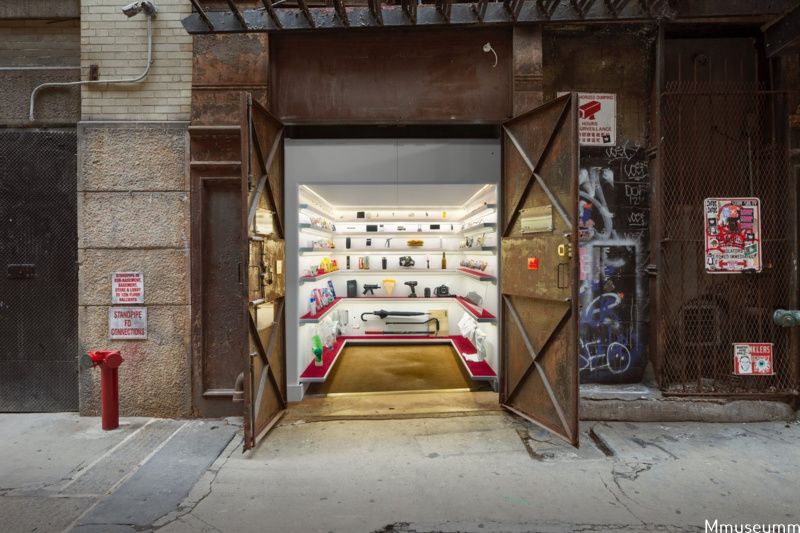
Occupying just 60 square feet inside a single, abandoned elevator shaft in Cortlandt Alley is Mmuseumm. As a modern natural history museum, Mmuseumm features artifacts that illustrate the complexities of the modern world. Items on display can range from toothpaste tubes from around the world to old-school childhood dolls and inflatable pool packets. Quirkier artifacts have included a collection of cornflakes and even a dildo with an LED light inside of it, which was mistaken for a bomb. This year, the museum is highlighting hundreds of objects organized into 17 world-wandering exhibitions that explore the nature of power in modern society. In addition, despite its tiny size, Mmuseumm still has its own cafe and gift shop for visitors.
The museum was founded in 2012 by Alex Kalman and the Safdie Brothers — an American independent filmmaker and actor duo known for writing and directing the 2017 thriller film Good Times starring Robert Patterson. In 2015, Mmuseumm opened a second location three doors down. It was designed by artist Maira Kalman — Alex Kalman’s mother — as an exact replica of her mother Sara Berman’s West Village apartment closet. Inside the closet replica are Berman’s old coats and shoes, creating a cramped yet organized space that according to the New York Times “represented a universal need to create order.” Both museums are open Friday through Sunday from 11:00 a.m. to 6:00 p.m. At $10 a ticket, Mmuseumm is the perfect spot if you’re looking to branch out beyond some of New York City’s most classic museums.
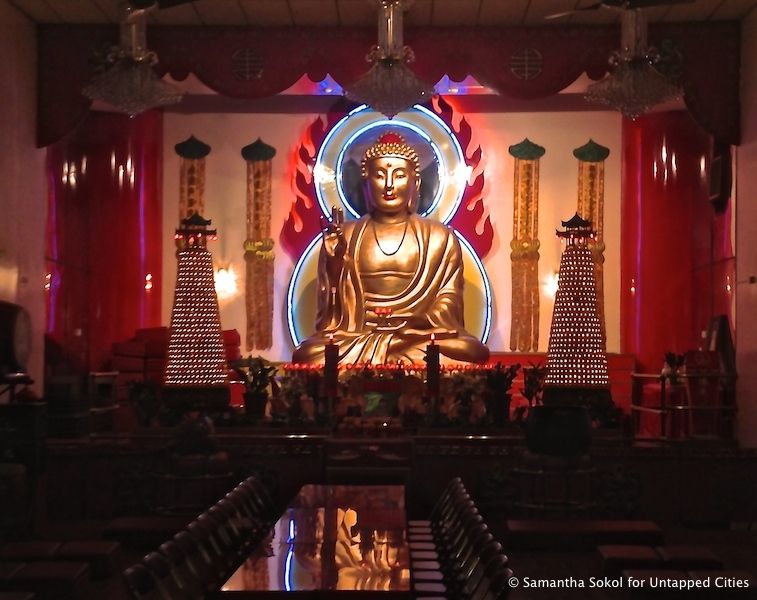
Located at the Mahayana Buddhist Temple at 133 Canal Street is the tallest Buddha statue in New York City. In the back room of the temple, the statue towers over visitors with a height of 16 feet. This Buddha sits atop a giant lotus flower and has an ethereal blue halo around its head that illuminates the room. Surrounding the statue are tables meant for families to provide offerings to deceased relatives.
Not only does the Mahayana Temple house the largest Buddha statue, but it is also the city’s largest Buddhist temple. Known as the “City Campus,” the Mahayana Temple is part of the church organization “Eastern States Buddhist Temple of America,” which was co-founded by Annie and James Ying. Other branches of the organization include one on 64 Mott Street and another in the forests of Cairo, New York.
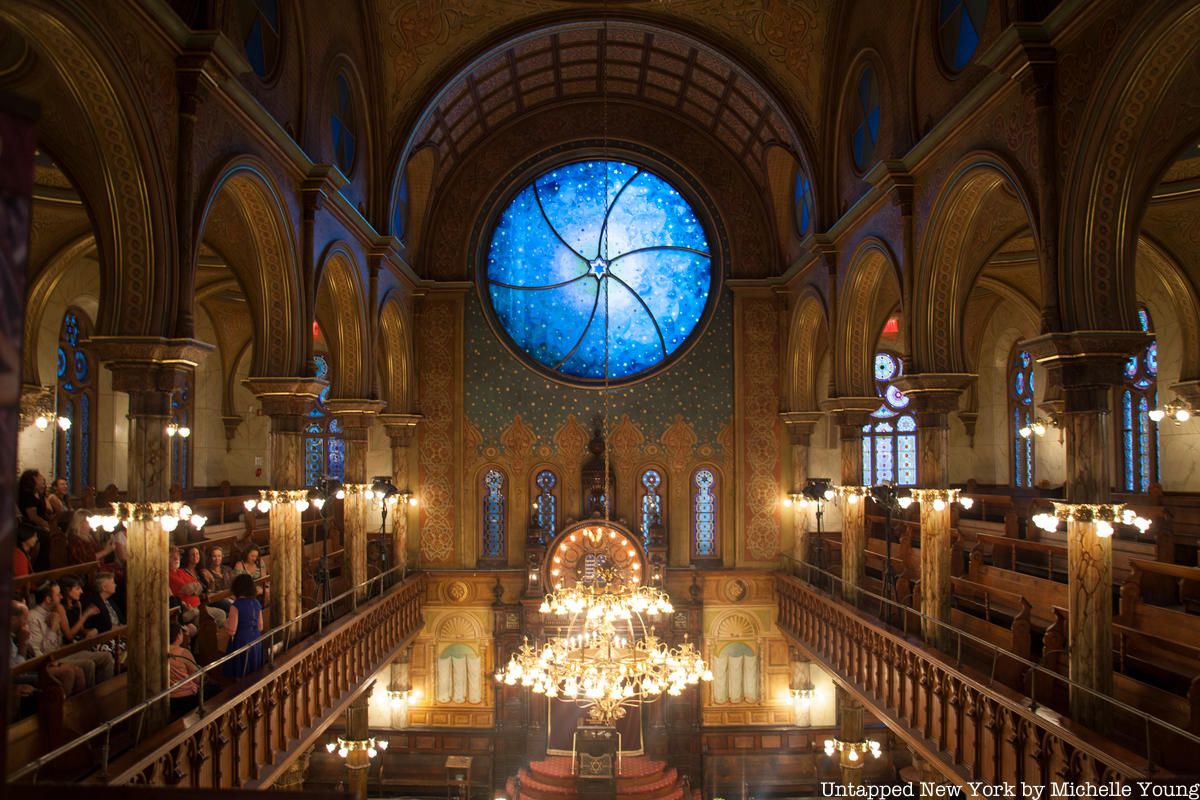
The Eldridge Street Synagogue, located at 12 Eldridge Street, was built in 1887 — becoming the first synagogue in the United States purposely built by Jewish Eastern European immigrants. It served as a spiritual home for immigrants from Russia, Poland, Lithuania, and other Eastern European countries — allowing them to proudly display their heritage and faith. For the following fifty years, the synagogue flourished, hiring world-renowned cantors to sing. However, after the introduction of the 1924 Immigrant Quota Laws and an exodus of the Jewish community into the outer boroughs, the synagogue began to decline.
During the 1940s, the congregation was forced to relocate to the synagogue’s lower level chapel after being unable to afford to take care of the grand main sanctuary, which was left to deteriorate until it was rediscovered in 1986. Emergency repairs were conducted to restore it and the building was designated a New York City landmark in 1996. After 20 years of restoration, the synagogue was rededicated as the Museum at Eldridge Street in December 2007.
In 2010, the synagogue’s eastern window was replaced with a 6,000 pound stained-glass rose window designed by artist Kiki Smith and architect Deborah Gans. The stunning window features a traditional six-pointed Star of David, with a collection of five-pointed stars spread across a blue backdrop. Currently, it is the only 21st century addition to the structure, Though the Eldridge Street Synagogue is surrounded today by the bustling Chinatown community, it continues to embody its Eastern European heritage, offering tours, school programs, concerts, talks, and festivals in celebration of the building’s history.
As one of New York City’s last great traditional arcades, Chinatown Fair Family Fun Center has managed to survive despite the surge of at-home video game consoles, hand-held gaming devices, and smartphones. Chinatown Fair opened in 1944, occupying the first floor of the popular Port Arthur Chinese Restaurant building at 7-9 Mott Street. At first, it operated as a penny arcade and small museum before becoming a video game arcade during the 1970s. In 1982, the arcade was purchased by an Indian immigrant named Sam Palmer.
Popular retro generation games at the arcade included classics like Pac-Man and Space Invaders. After the release of Street Fighter II: The World Warrior in 1991, Chinatown Fair switched to focusing on competitive fighting games with top professional fighting game players like Justin Wong and NYChrisG frequenting the establishment.
Things began to change for Chinatown Fair when it closed down in February 2011, only opening one year later on May 5, 2012, under the new leadership of Lonnie Sobel. To appeal to a new clientele, Chinatown Fair Family Fun Center as it was newly named, introduced more family-friendly games. This shift caused criticism among competitive players who lamented the arcades’ switch to catering more towards casual players. Eventually, many of these players migrated to Next Level, a Brooklyn arcade owned by Chinatown Fair’s former manager. Most recently, in 2015, the arcade was featured in the documentary The Lost Arcade, which focused on the influence of Chinatown Fair on the fighting game community and New York City as a whole.

Over the years, Chinatown has been featured across multiple well-known film and television productions. One such example is Taylor Hackford’s 1997 American supernatural horror film The Devil’s Advocate, starring Keanu Reeves and Al Pacino. Based on Andrew Neiderman’s 1990 novel of the same name, the film follows the story of a successful Florida lawyer named Kevin Lomax, who is invited to New York to work on a major film. As his wife slowly becomes haunted by strange visual phenomena, Lomax realizes that his boss is actually the Devil. In one of the film’s most poignant scenes, Pacino as the devil takes a stroll with Reeves as the lawyer, with the two cutting through the intersection on Mott and Canal to end up on Houston Street, standing at one point right in front of the United Orient Bank.
Other films featuring Chinatown include Andrew Bergman’s 1990 American crime comedy film The Freshman, starring Marlon Brando and Matthew Broderick, and Michael Cimino’s 1985 film Year of the “Dragon, which focuses on a Vietnam vet-turned-cop played by Mickey Rourke fighting Chinese gangs. In Men in Black 3, Agents K and J, played by Tommy Lee Jones and Will Smith, engage in an epic fight with an elusive alien in Wu’s Diamond Garden Seafood restaurant. Another influential film featuring Chinatown is Abel Ferrara’s 1990 King of New York, which starred Christopher Walken. During the film, the neighborhood serves as a backdrop for a shootout between Walken’s henchmen and the Chinese Tong gangs. On television, the neighborhood has made appearances in Law and Order: Special Victims Unit, Gotham, and Billions — where the main cast have stopped by popular locations including the Peking Duck House and Foot Heaven.
Next, check out NYC’s China Institute, The Oldest Chinese Bicultural non-profit in America!
Subscribe to our newsletter